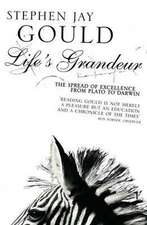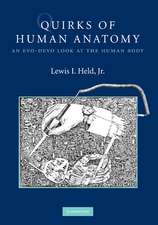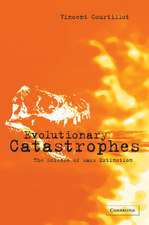An Ape's View of Human Evolution
Autor Peter Andrewsen Limba Engleză Hardback – 6 ian 2016
Preț: 364.80 lei
Nou
Puncte Express: 547
Preț estimativ în valută:
69.80€ • 73.08$ • 57.76£
69.80€ • 73.08$ • 57.76£
Carte disponibilă
Livrare economică 15-29 martie
Preluare comenzi: 021 569.72.76
Specificații
ISBN-13: 9781107100671
ISBN-10: 1107100674
Pagini: 328
Ilustrații: 110 b/w illus. 5 colour illus. 4 tables
Dimensiuni: 180 x 252 x 20 mm
Greutate: 0.79 kg
Editura: Cambridge University Press
Colecția Cambridge University Press
Locul publicării:New York, United States
ISBN-10: 1107100674
Pagini: 328
Ilustrații: 110 b/w illus. 5 colour illus. 4 tables
Dimensiuni: 180 x 252 x 20 mm
Greutate: 0.79 kg
Editura: Cambridge University Press
Colecția Cambridge University Press
Locul publicării:New York, United States
Cuprins
Preface; 1. How can we recognise common ancestors?; Part I. Apes – Their Morphology and Behaviour: 2. Morphology and behaviour of living apes; 3. Human and ape phylogenies; 4. Review of fossil apes; Part II. Environments and Palaeoenvironments: 5. Structure and composition of ape environments; 6. Environmental indicators; Part III. Review of Fossil Apes - Morphology and Environment: 7. The view from the Early Miocene; 8. The environment in the Early Miocene; 9. The view from the Middle Miocene; 10. Specialised apes from the Middle Miocene; 11. The environment in the middle Miocene; 12. A second view from Europe; 13. The environment in Europe; 14. Late Miocene to Pleistocene apes; 15. Apes, hominins and environment in the Late Miocene; Part IV. Last Common Ancestor: 16. Putting together the evidence; 17. An ape's view of human evolution; References and further reading; Index.
Recenzii
'Peter Andrews draws on more than four decades of research and personal recollections in this engaging and thought-provoking review of how the evolution of apes informs us about human origins. Importantly, Andrews goes beyond the fossil evidence of the teeth and bones to reconstruct the paleobiology and paleoecology of our antecedents, and thus offers a unique perspective on the remarkable evolutionary events that ultimately gave rise to modern humans. This is an extraordinary tale worth telling, and there is no one better than Peter Andrews to tell it.' Terry Harrison, New York University
'Ape evolution extends back in time more than 20 million years earlier than that of humans, with a more diverse array of species. Yet, there has not been a single book dedicated to interpreting that rich fossil record in itself or with respect to the emergence of humans. An Apes View of Human Evolution by Peter Andrews now fills that void. Reflecting Andrews' unique - for a paleoanthropologist - early background in forestry, the book's perspective centers on paleoenvironments, how they have influenced diversity among apes and the spread of apes throughout the Old World during the Miocene. The book also focuses on the sites and fossils that Andrews has worked on most extensively, which span much of the Miocene and Pliocene. Thus, it is both a guide to the record of ape evolution leading to the emergence of humans as well as a captivating personal narrative of exploration.' Jay Kelley, Arizona State University
'Peter Andrews is a holistic thinker and this book is the culmination of his long career weaving primate evolution, human evolution and palaeoecology into an insightful and coherent narrative. Here he tells us not just what we know about our evolutionary past, but why and how we know it in the first place. This book is a rigorous and insightful explanation of hominid evolution from the early Miocene onwards, providing readers with the theoretical and interpretive tools necessary for thinking independently about the subject - this will benefit not just students, but those of us already engaged professionally with the discipline. In addition, it's something of a memoir - unapologetically personal at times, yet clear and unbiased in the presentation of information. It will replace any advanced teaching or reference text that you've previously considered an indispensable resource!' Kris Kovarovic, Durham University
'There are excellent summaries at the ends of each chapter and also at intervals within the main text to emphasise the key points. … this is an easy and enjoyable read. …an essential book for anyone interested in fossil apes, but also it will interest anyone who wants to know more about some of the personalities and achievements of 20th century palaeoanthropologists and that certainly broadens the audience.' Bill Sellers, Primate Eye
'It is clearly written in textbook style, with just the right amount of background to set the stage, just the right amount of detail to keep readers engaged, and useful summaries at the end of each chapter. It is a reflection of a great scientist's career. I am enthusiastic in my recommendation of this volume to all who wish to learn more about ape evolution and human origins.' David R. Begun, The Quarterly Review of Biology
'Ape evolution extends back in time more than 20 million years earlier than that of humans, with a more diverse array of species. Yet, there has not been a single book dedicated to interpreting that rich fossil record in itself or with respect to the emergence of humans. An Apes View of Human Evolution by Peter Andrews now fills that void. Reflecting Andrews' unique - for a paleoanthropologist - early background in forestry, the book's perspective centers on paleoenvironments, how they have influenced diversity among apes and the spread of apes throughout the Old World during the Miocene. The book also focuses on the sites and fossils that Andrews has worked on most extensively, which span much of the Miocene and Pliocene. Thus, it is both a guide to the record of ape evolution leading to the emergence of humans as well as a captivating personal narrative of exploration.' Jay Kelley, Arizona State University
'Peter Andrews is a holistic thinker and this book is the culmination of his long career weaving primate evolution, human evolution and palaeoecology into an insightful and coherent narrative. Here he tells us not just what we know about our evolutionary past, but why and how we know it in the first place. This book is a rigorous and insightful explanation of hominid evolution from the early Miocene onwards, providing readers with the theoretical and interpretive tools necessary for thinking independently about the subject - this will benefit not just students, but those of us already engaged professionally with the discipline. In addition, it's something of a memoir - unapologetically personal at times, yet clear and unbiased in the presentation of information. It will replace any advanced teaching or reference text that you've previously considered an indispensable resource!' Kris Kovarovic, Durham University
'There are excellent summaries at the ends of each chapter and also at intervals within the main text to emphasise the key points. … this is an easy and enjoyable read. …an essential book for anyone interested in fossil apes, but also it will interest anyone who wants to know more about some of the personalities and achievements of 20th century palaeoanthropologists and that certainly broadens the audience.' Bill Sellers, Primate Eye
'It is clearly written in textbook style, with just the right amount of background to set the stage, just the right amount of detail to keep readers engaged, and useful summaries at the end of each chapter. It is a reflection of a great scientist's career. I am enthusiastic in my recommendation of this volume to all who wish to learn more about ape evolution and human origins.' David R. Begun, The Quarterly Review of Biology
Notă biografică
Descriere
This book brings together ecology, evolution, genetics, anatomy and geology to provide a new perspective on human evolution from the apes' viewpoint.













